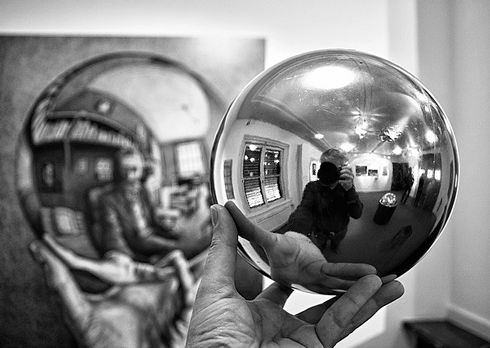What makes you smarter? I bet you have a pretty good idea by now. Personally, I get a little smarter every time I’m behind the edit pane of this blog. I have a new bit of research to share that might even help reaffirm this little claim. Now, I don’t really know if you are actually getting smarter by being where you are right now, on the outside of the blog looking in… reading. I can assume you are getting smarter by reading this blog with about the same level of certainty that I can say my students got smarter by listening to me talk.
Reflection
For most savvy educators, the metacognitive power of reflecting upon learning is no secret. I think few in the business would refute that assertion. And yet, I have long believed that we do not take this practice serious enough to truly nourish it until it flourishes.* The practice of careful and explicit reflection embedded throughout the process of learning is a far, far cry from the practice of merely assigning reflective thinking. As dialed-in to this practice as I am, I can’t say I’ve personally nailed it down to the: “Four Steps to Winning via Reflection.” Believe me, if I could write that blog post I would. The reality is that most of what it takes to support deep, meaningful learning is far too nuanced for a bulleted blog post hitched to a cocky title.
What I can say, however, is that at some point in my teaching career, I stumbled upon the advantages of thoughtful, coached reflection. If you’re tackling a concept sophisticated enough to require a bit of struggle, then you can benefit from careful reflection. Thankfully, I discovered this early enough in my career to be able to figure out -by trial and error- some thoughtful ways of encouraging, supporting, and embedding this type of thinking. I later learned this to be the seventh of the Seven Strategies of Assessment for Learning by Jan Chappuis:
Strategy 7: “Engage students in self-reflection, and let them keep track of and share their learning.” – Long-term retention and motivation increases when students track, reflect on, and communicate about their learning. In this strategy, students look back on their journey, reflecting on the learning and sharing their achievement with others.
On Assignment
Again, contrast this embrace of the nuances of learning with the mere practice of assigning reflection. I reiterate this to insure that you don’t simply read the linked article, start assigning it on Monday, wonder why Friday’s quiz scores are no better, and then drop the practice as another failed attempt at smartering**. In fact, I would have to say this reminds me of a rather worn out practice within online/blended modes of schooling: the “post once, comment twice” approach. That protocol arises out of the fact that we would like to see a back and forth exchange of information in these new spaces. We’d like to see students engaged in conversation as an additional mode of learning. We’ve spent a great deal of time and effort to figure out how to support this sort of discourse in physical space. I’m guessing most of us would be far happier if it just “happened” for us in online spaces as well. It makes sense that we’d rather not have to spend the time and effort figuring out yet one more way to interact when we’ve already got this surefire way that still “works.” And thus, attempts at online learning experiences often fall far short on most measures of authentic engagement.
In short: without at least a measure of careful attention to fostering content conversations and open self-monitoring of learning… reflection becomes yet another hoop to jump through. Experience tells me that assignments created without either input from or options for the learners themselves… are a hoop. And before you label me a radical constructivist, I do believe students should engage in “path shaping” experiences designed by a learning expert. The degree to which those experiences are seen as “hoops” is entirely dependent upon design. Photocopy it from a text resource? Hoop. Include little more than low-level regurgitation of dogma? Hoop. Fail to help build a context for the work? Hoop. Require it to be done as a movie, merely because you can? Hoop. Every student in the class looking for the same “right answer?” Hoop. Less than timely and non-descriptive feedback on said assignment? Hoop.
Now More Than Ever
The list goes on and on. It takes serious effort to design learning ecosystems and experiences that are more than a collection of hoops to jump through. Teaching and learning are sophisticated endeavors. The world has changed. We don’t need to attend school to collect facts anymore. We can do that from our handheld devices. If you are still caught in a tell me things on Monday-I write it all down-you quiz me on Friday cycle, your approach has been seriously disrupted by the modern world and is ripe for reinvention. Start by studying self-reflection strategies. Perhaps now more than ever, what we do need to attend school for… is to seek wisdom: the quality of having experience, knowledge, and good judgement. I would further suggest that the road to wisdom is paved with reflection upon thoughtful reflection.
Getting down to specifics, purposeful self-reflection can help students on the path to wisdom in many ways. Coaching students through self-reflection on their learning process can help them…
- see changes and development over time
- deeply appraise their own learning process
- take ownership of their own learning
- diagnose gaps in their learning
- select strategies that support their learning
- find confidence in risk taking and inquiry
- set goals for future learning
This Just In
The reason for returning here to think deeply about reflection was an EdWeek post from a few weeks ago entitled, Post-Lesson Reflection Boosts Learning by Ellen Wexler. The post outlines a study done via the collaboration of researches from HEC Paris, Harvard, and the University of North Carolina. The original paper, Learning by Thinking: How Reflection Aids Performance, can be directly downloaded on the Social Science Reasearch Network. The author highlights the measurable boost in self-efficacy which is thought to be much of the fuel for the results shown. That is no doubt a significant factor, but I think there is more to it than that. I believe there is still much work to be done in this area.
To be clear, I don’t usually put a great deal of stock in the educational application of research fresh out of business school. Learning is learning, however, and this reminds me of so many practical action research projects my former students and I conducted along the way in any given year. Explicitly engaging students in my personal quest to learn more about learning was full of win. Tossing aside the mystique of schooling and involving students in the process helps to put them front and center in the classroom… where they belong. Get a start this summer. Read this article. Read the Stiggins and Chappuis stuff. Design one small way to make rich student reflection on learning more than another classroom hoop.
In Addition
*Nourish it until it flourishes: I think I’ll use this phrase again. It has an almost musical-internal-rhyme-Marshall Mathers-sort of thing going on. Or something.
**Smartering: A Michael Gier term for the goodness that takes place within the mindspace that is his classroom.
Finally, thanks to Bert Kaufmann for sharing A Very Escher Christmas, and Joel Penner for sharing “Hoop Jumping” both via CC license on Flickr.


Ready to break free from the chains of conformity? Learn how to introspect and live authentically today!